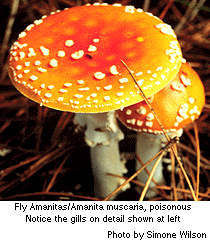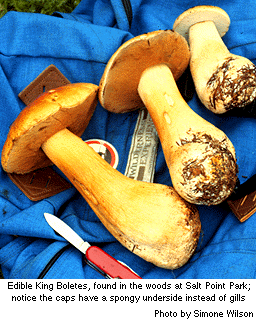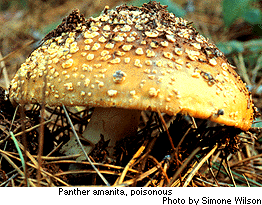| |
 Sam Sebastiani, Jr., died at UCSF Medical Center Jan. 14, nine days after eating amanita phalloides, a mushroom so toxic it's nicknamed the "deathcap." The 32-year-old Sebastiani was the great-grandson of Samuele Sebastiani, who founded Sebastiani Vineyards in Sonoma in 1904; his father, Sam, Sr., is the owner of Viansa Winery in Sonoma Valley. He was foraging with friends after the recent rains and mistook the deadly amanitas for edible look-alikes. (Most amanitas are poisonous; the amanita family causes 90 percent or more of fatal mushroom poisonings.)
Sam Sebastiani, Jr., died at UCSF Medical Center Jan. 14, nine days after eating amanita phalloides, a mushroom so toxic it's nicknamed the "deathcap." The 32-year-old Sebastiani was the great-grandson of Samuele Sebastiani, who founded Sebastiani Vineyards in Sonoma in 1904; his father, Sam, Sr., is the owner of Viansa Winery in Sonoma Valley. He was foraging with friends after the recent rains and mistook the deadly amanitas for edible look-alikes. (Most amanitas are poisonous; the amanita family causes 90 percent or more of fatal mushroom poisonings.)
 The amanita phalloides' flamboyant cousins, the fire-engine red amanita muscaria and the tawny "panther" amanita (see below) are common in North Coast woodlands. They're easily identifiable by their colors and by the oatmeal-like flecks generally found on the fully-formed cap. But the greenish-white amanita phalloides masquerades as a harmless field mushroom and can even fool experienced mushroom hunters.
The amanita phalloides' flamboyant cousins, the fire-engine red amanita muscaria and the tawny "panther" amanita (see below) are common in North Coast woodlands. They're easily identifiable by their colors and by the oatmeal-like flecks generally found on the fully-formed cap. But the greenish-white amanita phalloides masquerades as a harmless field mushroom and can even fool experienced mushroom hunters.
Heavy fall and winter rains, followed sunny weather, provide ideal growing conditions for mushrooms, including amanitas. After the latest winter storm, eight other grew ill from eating wild mushrooms but recovered. Last year 13 Bay Area people got sick from eating them, including a Petaluma farmworker who died and a Taiwanese immigrant who recovered after a partial liver transplant. (Amanitas destroy the liver's ability to function.)
Mushrooms thrive in a moist, warm climate; the wet temperate zone of the Pacific Northwest is a near-perfect nursery for fungi. Despite the potential danger, mushroom hunters are as zealous as sport fishermen, and just as reluctant to reveal their favorite spots. One commonly acknowleged hunting ground, though, is Salt Point State Park, two hours north of San Francisco.
| |
To prevent overpicking, State Parks has limited sport pickers to a five-pound haul. Commercial picking is banned so the mushrooms will have a chance to reproduce. Some varieties, like hedgehog mushrooms, sell for $13 a pound in North Bay markets, and they're hard to find at Salt Point these days; overzealous pickers probably wiped them out.
"We've come across people with crates full of mushrooms," says Caerleon Safford, interpretive specialist for Fort Ross, five miles down the road. That's way over the five pound limit; the rangers cite them for violating park rules and send them home with empty crates. For now, Fort Ross Park has put the lid on mushrooming altogether to let the mushrooms recover.
We would be wildly lucky to find five pounds, although one hefty, full-grown cep could hit the scales at a couple of pounds. The cep -- also called Steinpilz, King Bolete and Boletus edulis -- is the darling of mycophagists, as mushroom eaters call themselves. Like all boletes, the King has a spongy underside instead of gills, making it almost impossible to mistake it for anything else. The King Bolete has about 200 cousins in North America, most of them edible. (The rule of thumb is to avoid boletes with orange or red undersides, which don't pop up in coastal California anyway.)
 The Kashaya Pomo, who have lived in this part of the coast for the last 40 or 50 centuries, call the King Boletus cepohkol, "mushroom hole on the-bottom;" they baked it on hot stones. The amanita muscaria they call ma-ti-hoce, "poison oak mushroom," a name that implies they know to leave it alone.
The Kashaya Pomo, who have lived in this part of the coast for the last 40 or 50 centuries, call the King Boletus cepohkol, "mushroom hole on the-bottom;" they baked it on hot stones. The amanita muscaria they call ma-ti-hoce, "poison oak mushroom," a name that implies they know to leave it alone.
"Look at those holes in the pine needles," says Marcus. "The Italians have preceded us." He points with chagrin -- and a trace of grudging admiration -- at several whorls where mushrooms have been plucked from the thick carpet of pine needles. Marcus lives in Occidental, a town largely settled by Italian immigrants who brought their mushroom lore to California. He imagines squads of Italian/Americans combing the woods, always just ahead of us, filling their baskets with boletes and chanterelles. It's his explanation for the ones that got away. For all we know, deer nosed up the missing mushrooms and ate them.
| |
Why do people hunt for mushrooms? A mushroom-studded forest is a natural gallery of shapes, colors, scents, and tastes, from the yellow goo of Witches Butter to the shiny rose and purple hues of the russulas, from tall skinny Shaggy Manes to funnel-shaped chanterelles. Even the names are entertaining. Some are whimsical: Orange Mock Oyster, Jelly Crep, White Cheese Polypore, Hen of the Woods. Others are just plain yucky: Slimy Lactarius, Turpentine Waxy Cap, Bleeding Agaricus.
Mushrooming is like fishing -- it's a good excuse to get outdoors amble around in a beautiful place, even if you never find a mushroom. And for mycophagists, a wild mushroom soup or a plate of mushrooms sauteed in butter and garlic evokes the scent of the pine woods.
Aside from picking and eating mushrooms, you can simply observe them in their natural habitat. If you're hoping to photograph them, a tripod is a plus, since mushrooms prefer dark moist corners where available light is dim.
The mushroom is a sly, elusive quarry -- it grows in dark corners, and if it isn't picked quickly, it vanishes back into the soil. Hunting and gathering are generally frowned on in state parks, but some parks allow mushroom picking because the fungi pop up suddenly and turn to wet pulp within a few days anyway (that's the mush in mushroom).
Ethnic groups with a tradition of mushrooming, the French and Italians, for instance, also retain some of their spore lore. But transplanted folk wisdom can trip us up -- some California poisoning cases have involved Southeast Asian immigrants, who mistook deadly North coast mushrooms for innocuous ones back home.
| |
Mycology societies are popular from Australia to Europe to the Pacific Northwest, and they've pollinated the web with myco-sites, from Mycologist On-line, to the Puffball (put up by the Willamette Valley [Oregon] Mushroom Society) and the jaunty Spores Afield, created by the Colorado Mycological Society. The Mycology Society of San Francisco is the nation's largest society for mushroom aficionados.
Most groups offer classes, slide shows and guided walks to initiate novice mushroom hunters. Enjoy the woods, but please, please be careful out there.
 | "Nature's Grocery Store" |

